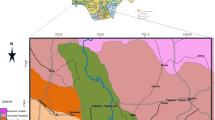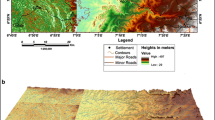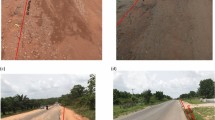Abstract
Mineralogical, geochemical and geotechnical analyses were carried out to evaluate the contributions of geological and geotechnical properties of subgrade soils to the incidence of failure of the Ipele–Isua road, south-western Nigeria. Field observations showed that the road is in a very poor state of disrepair as major portions of the road alignment have failed. The road alignment is underlain in places by Quartz Schist, Banded Gneiss and Granite Gneiss. The results of the laboratory tests revealed that the natural moisture content ranges from 6.5 to 23.3%, liquid limit from 20.1 to 55.1%, plasticity index 5.2 to 22.2%. The grain size analysis showed that the amount of fines ranges from 13 to 60.8%. Others are linear shrinkage between 2.9 and 11%, free swell between − 16.67 and 41.94%, maximum dry density from 1520 to 1792.1 kg/m3 and CBR between 2 and 17%. The specific gravity ranges from 2.51 to 2.63. The major clay minerals present are kaolinite and dickite with dominance in 50% of the samples. Major oxides present are SiO2, Al2O3, Fe2O3, K2O. Na2O, MgO and CaO are generally less than 1%. Based on AASHTO classification, 19% of the samples are classified as A-2-4, 33% classified as A-2-6 while 44% classified as A-7. Dominance of low California bearing ratio, low maximum dry density, high linear shrinkage and A-7 soil group expectedly contributed to poor geotechnical properties of the subgrade. Absence of drainage is suspected to have worsened the failure as exhibited on the road.
Similar content being viewed by others
Introduction
Economic importance of road has increased enormously over the last decades in Nigeria and to a large extent, they are complementary to other modes of transportation. However, the deterioration of a road begins soon after construction. Some of the roads in Nigeria do not last up to 5 years before failure becomes imminent. Road failure has been defined in different ways by various authors. According to [14], a road stretch is said to have failed when a part or all the parts of the road surface or any part of the road structural section or the entire road prism or pavement at any point along the highway is deformed and rendered un-motorable. Highway failure occurs when the road no longer performs its traditional function of providing continuous smooth surface for minimal frictional movement of vehicles. When such failure occurs before the anticipated design life, it is rightfully described as premature [5]. Highway premature failure occurs within the highway pavement structure or the road foundation or both. It may also be as a result of problems beside the highway with consequent effect on the pavement and/or foundation. Failure of highway pavement structure or foundation manifests in the form of various categories and degrees of distress on the pavement surface. The failure of roads is not an uncommon occurrence all over the world; however, there has been an upsurge in the failure of roads in Nigeria in recent information about the subsoil materials upon which these roads are built. The road under study is a major highway which is in a bad condition as it is characterized by various forms of deformation features that are responsible for pavement instability. These deformations develop on this road pavement in various forms, magnitude and frequency. They often cut sufficiently deep into the structural section of the highway thereby limiting human and vehicular movement, hence not justifying the huge amount of money spent on its construction. The key to proper maintenance of asphalt pavements is to understand the types and causes of failures and the action needed for correction before any repair work is done. Consequently, the thrust of this study is to determine the engineering geological properties of subgrade soils in the study area and their contribution to road’s failure.
Study area
The study area is located within the southwestern part of Nigeria. The road is a 56 km stretch which connects Ipele to Isua and serves as a link to several other parts of the country. The study area (Fig. 1) is located between longitudes 5°38′E to 5°0.57′E and latitudes 7°07′N to 7°27′N. The area enjoys a prevalent humid tropical climate marked by alternating wet and dry seasons. The wet season begins in April and ends in October while the dry season spans from October to March. The mean annual rainfall is about 1375 mm and the rainfall pattern is bimodal in nature, with an annual maximum in the month of June and a secondary maximum in the month of September (Balogun [6]). Average yearly temperature also varies from 22 °C (wet season average) to 30 °C (dry season average) while the humidity varies from 40% (December average) to 80% (July average). The entire zone of study has damp air which comes from the Atlantic Ocean most of the year.
Geology and soils in the study area
The study area is underlain by rocks of the Precambrian Basement Complex. The area is underlain mainly by Quartzites, Schist, Migmatites and Gneiss. The Schists generally outcrop poorly; they are mostly low-lying as a result of their low resistance to weathering. Migmatites occur inselbergs and range of hills (Rahaman and Malomo [28]). The Gneisses consists of alternating parallel to sub-parallel dark and light bands. The road alignment is underlain by Schist, Banded Gneiss and Granite Gneiss which are all metamorphic rocks of Pre-Cambrian age. The surface soils in the study area are residual lateritic materials composed of greyish to reddish brown, loose medium to coarse grained mineral matters with some clayey materials. The soils are however dark in colour in areas with vegetation cover probably as a result of decomposing flora and fauna. The relief is of relatively irregular and undulating terrain of crystalline basement rocks. There are many ridges in the study area, in some cases, the rocks occur as inselbergs and have heights varying from 150 m in some places to 570 m in others (Fig. 2). The area is dominated by dendritic drainage pattern and this suggests fairly homogeneous resistance of the underlying rocks to weathering.
Topographic map of the study area showing the sampling points [16]
Materials and methods
In the course of the field work, a visual reconnaissance survey was undertaken to evaluate and assess the physical conditions of the highway pavements. The underlying rocks were identified and their structural trends were noted. Twenty-five bulk disturbed soil samples were collected into polythene bags from subgrade materials in borrow pits along the roadsides adjacent to the failed sections in such a way that the soil samples represent the different topographic conditions of the road alignment. The natural moisture content of each of the samples collected was determined immediately it was taken to the laboratory. This was followed by air drying of all the samples for 1 week to obtain fairly constant moisture content. The soil tests carried out are Atterberg Limits, linear shrinkage and free swell. Others include grain size and hydrometer analysis, specific gravity, natural moisture content, compaction and California Bearing Ratio (CBR). The tests were done following British Standard Institution [11] methods of testing for civil engineering purposes. Mineralogical and geochemical analyses of ten representative soil samples was undertaken using X-ray diffraction and fluorescence methods. Using the method by [12] the clay minerals were identified while the percentage abundance was calculated using area method [19].
Results and discussions
The road conditions
The road under study is a flexible pavement which consist of the subgrade, subbase, base and the wearing course. The subgrade being the natural soil serves as the foundation of the road. This is directly overlain by the subbase which is made up of soils imported from designated sites. The base of the road is made of aggregates derived from basement rocks from the area while the wearing course consist of bitumen. As at the time of study, a major portion of the road alignment has failed. Pavement distress was manifest in various forms such as cracks, pot holes, corrugations, ravelling and rutting along the road alignment (Fig. 3a, b). In some portions of the road the cracks, corrugations and potholes often gets to two metres wide and m deep (Fig. 3c–e). The various types of failure at different locations are described in Table 1. It was also noted that the road is completely devoid of drainage facilities.
a An intensely cracked portion of the studied road at location 2. b A completely broken down portion of the road alignment at location 3. c A completely broken down and corrugated section of the studied road. d A pothole at location 7. e A completely broken down section of the road alignment at location 10
Geotechnical properties of the soils
Summary of results of geotechnical tests is presented on Table 2. The values of in situ moisture content will vary depending on the depth of the soil sample, antecedent rainfall (seasons) and prevailing drainage conditions [8]. The seasonal high variation in the moisture contents of soil will cause large volume changes in the clayey soils. Underwood [30] proposed that soils with natural moisture content of 5%–15% are suitable engineering materials while soils with natural moisture content values ranging from 20 to 35% are unfavorable engineering materials. The values of moisture content obtained for the soil samples range from 6.5 to 23.3. A comparison of the test result with the Underwood proposition indicates that only eight samples have unfavorable to marginally favorable natural moisture content values. The result of the grain size analysis of the samples is presented on Table 2 while Figs. 4 and 5 give the summary of the grain size curves. The dominant grain sizes vary from sandy silt to clayey sand. The clay fraction expectedly exerts a dominant influence on the mass behavior, even when present in small proportion in any soil sample for engineering use. A comparison of the test results with [15] specification which requires subgrade soils to possess less than 35% fines, 52% of the samples met the requirement while 48% did not fulfill the requirement. The consistency limits give much information on the behavior of clays than the grain size data [20] and it is thus an important factor in the selection of the subgrade and sub-base materials. Excessive plasticity often leads to waviness, which is a road failure that results from plastic flow of soil upon the application of axle load [2, 3]. The liquid limit values range from 20.1 to 55.1%. Soils with very high liquid limit tend to possess low bearing capacity. The [15] specification for road materials recommends that for a material to be suitable as a subgrade it should possess a liquid limit less than 40%. Forty-four percent of the studied samples do not satisfy this specification while the other 56% satisfy the specification. The plastic limit values range from 15.3 to 34.6 while the plasticity index ranges from 5.2 to 22%. Only 20% of the studied samples do not satisfy the Nigerian specification that recommends a plasticity index of less than 20%. Eight percent of the samples are non-plastic while the rest of the samples meet the standard recommended. According to [24], the soils would exhibit low to medium swelling potential as they possess plasticity index values lower than 25%. The results were plotted on the [13] plasticity chart (Fig. 6) and 36% of the soils plot within the field of inorganic silts while 46% plotted in the field of inorganic clays. Only samples 1, 7 and 24 possess low plasticity while the rest falls within the field of medium plasticity while the rest falls within the field of medium plasticity. According to [13], soil samples with low, medium and high plasticity will have low, medium and high compressibility respectively. The characteristics of the soil groups are summarized on Table 2. Result of the soil classification shows that only 20% of the tested soils classify as A-2-4 soils while the rest 80% classify as A-2-6, A-5, A-6 and A-7 soils.
The linear shrinkage values of the soils range from 2.9 to 11. Soils having linear shrinkage values greater than 8% will be active and have critical swelling potential and are not good foundation materials [9, 24]. Sixty-eight percent of the samples have linear shrinkage values greater than 8% and are expected to be unsuitable subgrade materials. [17] noted that soils possessing linear shrinkage greater than 10% will pose field compaction problem, hence 28% of the samples will pose field compaction problems..
Specific gravity is known to correlate with mechanical strength of laterite aggregates and may be used as a basis for selecting suitable highway pavement construction materials particularly when used with other pavement construction materials [23, 26]. The values of the specific gravity of the studied soil using water range from 2.51 to 2.63 while that done with kerosene range from 3.09 to 3.0.41 (Table 2). The values of specific gravity conducted with water are generally lower than those conducted with kerosene.
Activity of the soil was obtained using [29] procedure by combining Atterberg limits and clay content into a single parameter. The degree of colloidal activity is expressed by the ratio of plasticity index to the percentage of the soil fraction finer than two microns. [29] suggested three classes of clays based on their activity viz; the inactive clays with activity values less than 0.75, normal clays with activity values ranging between 0.75 and 1.25 and the active clays with activity values greater than 1.25. The activity values (Table 2) ranges from 0.19 to 0.98, which suggest normally active to inactive clays; hence they possess low to medium expansion potential as obtained in the activity chart (Fig. 7).

(modified after [7])
Activity chart
The free swell values (Table 2) of the tested soils fall in the range of illite and kaolinite. Hence, they possess low to moderate swelling potential [4, 25]. The maximum dry density obtained from compaction tests ranges from 1520 to 1780 kg/m3 and the optimum moisture content ranges from 12 to 23% for the soil samples Based on [30] proposition, the soil samples have a fair to poor foundation characteristics. This relatively low maximum dry density value is expectedly a contributory factor to the frequent occurrence of road failure.
Federal Ministry of Works and Housing [15] recommends a California Bearing Ratio of greater than 10% for subgrade materials. The result shows that the California Bearing Ratio values of some of the soils are much lower than this value. The relatively low California bearing ratio values for the tested soils is in part responsible for the failure of highway pavement in the study area.
Geochemical and mineralogical properties
The mineralogies of ten selected soil samples is shown on Table 3. The major clay mineral types obtained are kaolinite and dickite. Minerals of the smectite group were not found. This is in agreement with [23] who did not find montmorillonite in any of the five genetically-different southwestern Nigerian soils studied. This is also consistent with the result obtained from the free swell test. Since kaolinite is usually associated with well-drained environment, it can be inferred that the study area is generally well-drained. Since kaolinite has the least affinity for water among the clay minerals, the studied soils will exhibit moderate expansion in the presence of water. Muscovite, a mineral of the mica group was found and may cause field compaction problems [18, 22, 25, 27]. This is reflected in the low values of maximum dry density obtained on the tested soils. The result of geochemical analysis is presented on Table 4. The major oxides present are silicon oxide, aluminum oxide and iron oxide. The studied soil samples are characterized by high amounts of silica (39.7–52.78 wt%), considerable amount of sesquioxides (Al2O3 and Fe2O3) 16–28.6 wt% and 2.75–28.31 wt% respectively and appreciable amount of bases (K2O and CaO).
The silica(S)/sesquioxides ratios(R) (Table 4) range from 0.82 to 1.69. [10] and [25] classified soils based on the silica/sesquioxides ratio as laterite if the is less than 1.33; lateritic if ratio ranges from 1.33 to 2 and non-lateritic if it is greater than 2. According to this classification, 40% of the studied soils classify as non-lateritic soils while the rest 60% are lateritic.
This result is in line with the expected condition of leaching in a warm environment like the study area [21] where silica is leached away from decaying silicate rocks concentrating secondary minerals like oxides of iron and aluminum as well as kaolinite in the soil.
Conclusions
From the geotechnical, geochemical and mineralogical investigations carried out in the study area, it can be concluded that:
-
1.
Lack of provision of drainage of the highway led to a reduction in strength characteristics of the subgrade as a result of ingress of water.
-
2.
Too high linear shrinkage characteristics (values higher than 8%) are likely to cause shrinkage problems in the soils, posing difficulties in field compaction.
-
3.
Based on [1] classification, 20% of the soils classify as A-2-4 while the remaining 80% classify as A-2-6, A-5 and A-7 soils with fair to poor subgrade characteristics.
-
4.
The low CBR values obtained on the tested samples is a major cause of failure in the study area as most of the soil sample recorded CBR values lower than the 8% specified by [15].
-
5.
Although the specific gravity values cannot be unilaterally related to the causes of road failure in the area, however, the relatively low specific gravity values obtained by the studied soils is in part responsible for failure of the road as an increase in specific gravity values indicates a decrease in voids ratio.
-
6.
The poor compaction characteristics has also resulted in the failure of the sections of the studied road.
References
AASHTO (1993) Guide for design of pavement structures. American Association of State Highway and Transportation Officials, Washington, DC
Adeyemi GO (1995) The influence of parent rock factor on some engineering index properties of three residual lateritic soils in southwestern Nigeria. Bull Int Assoc Eng Geol 52:3–8
Adeyemi GO (2002) Geotechnical properties of lateritic soils developed over quartz schist in Ishara area southwestern Nigeria. J Mining Geol 38(1):65–69
Aghamelu OP, Okogbue CO (2011) Geotechnical assessment of road failures in the abakaliki area, southwestern Nigeria. Int J Civil Environ Eng 11(2):12–24
Ajani AR (2006) Causes of premature road failures on highways. Trans-Saharan Road Liason Committee Stage, Tunisia
Balogun O (2003) Senior secondary atlas. Longman, Lagos
Bell FG, Maud RR (1995) Expansive clays and construction, especially of low-rise structures: a viewpoint from Natal, South Africa. Envirom Eng Geosci 1:41–59
Bowles JE (1984) Engineering properties of soils and their measurements, 4th edn. Mcgraw Hill Incorporations, Mcgraw
Brink ABA, Parridge JC, Williams AAB (1982) Soil survey for engineering. Clarederon, Oxford
BS 1377 (1990) Method of testing for soils for civil engineering. British Standard Institution, London
Camapum De Carvalho J, Rezende LRD, Cardoso FBDF, Guimaraes RC, Valencia YG (2015) Tropical soils for highway construction: peculiarities and considerations. Transport Geotech 15:3–19
Carrol D (1971) Clay minerals: a guide to their X-ray identification of soils. In: Geological society of America special paper 126, USA
Cassagrande A (1947) Classification and identification of soils. Am Soc Civil Eng. 113:783–811
Fadaka B (1989) Maintainance of federal highways. In: Conference paper, NIIT conference, Kano, Nigeria
Federal Ministry of Works and Housing (1997) Nigerian general specifications for roads and bridges. Federal Highway Department. 2:145–284
Federal Surveys of Nigeria (1966) Topographical map of owo. In: Sheet 265, 2nd edition. 1:100,000
Gidigasu MD (1973) Review of identification of problem laterite soils in highway engineering. Transport Res Board 497:96–111
Gidigasu MD (1976) Geotechnical evaluation of residual gravels in pavement construction. Eng Geol 15:173–794
International Joint Committee Properties on Mineral Powder Diffraction Standard (1980) Mineral powder diffraction file data book. IJCPS, Pennsylvania
Lambe TW (1951) Soil testing for engineers. Wiley, New York
Loughnan FC (1969) Chemical weathering of silicate minerals. Elsevier, New York
Ogunsanwo O (1988) Basic geotechnical properties, chemistry and mineralogy of some laterite soils from southwestern Nigeria. Bull Int Assoc Eng Geol 37:131–135
Okogbue CO (1988) The physical and mechanical properties of laterite gravels from south eastern Nigeria relative 36 to their engineering performance. J Afr Earth Sci 5(6):659–664
Ola SA (1983) Tropical soils of Nigeria in engineering practice. In: Ola SA, Balkama AA. Netherlands, pp 61–24
Onana VL, Ngooze A, MedjoEko R, Ntouala RFD, NangaBineli MT, Owoudou BN, Ekodeck GE (2017) Geological identification, geotechnical and mechanical characterization of charnokite-derived lateritic gravels from southern Cameroon for road construction purposes. Transport Geotech 10:35–46
Owoyemi OO, Adeyemi GO (2012) Highway geotechnical properties of some lateritic soils from the sedimentary terrain of Lagos–Ibadan highway. Int J Sci Eng Res 3(1):1–14
Paige-Green P (2003) Geology and petrology of road construction materials revisited. In: Paper presented at 13th ARCSMGE conference, Marrakech
Rahaman MA, Malomo S (1983) Tropical soils of Nigeria in engineering practice. AA Balkama, Netherlands, pp 17–38
Skempton AW (1953) The colloidal activity of clays. In: Proceeding of the 3rd international conference on soil mechanics, Zurich, pp 57–61
Underwood LB (1967) Classification and identification of Shales. J Soil Mech Found 93(11):97–116
Authors’ contributions
SOD conceived the study, participated in its design, conducted the fieldwork and laboratory analysis and drafted the manuscript. SM and YAA participated in the design of the study. All authors read and approved the final manuscript.
Competing interests
The authors declare that they have no competing interests.
Publisher’s Note
Springer Nature remains neutral with regard to jurisdictional claims in published maps and institutional affiliations.
Author information
Authors and Affiliations
Corresponding author
Rights and permissions
Open Access This article is distributed under the terms of the Creative Commons Attribution 4.0 International License (http://creativecommons.org/licenses/by/4.0/), which permits unrestricted use, distribution, and reproduction in any medium, provided you give appropriate credit to the original author(s) and the source, provide a link to the Creative Commons license, and indicate if changes were made.
About this article
Cite this article
Daramola, S.O., Malomo, S. & Asiwaju-Bello, Y.A. Premature failure of a major highway in southwestern Nigeria: the case of Ipele–Isua highway. Geo-Engineering 9, 28 (2018). https://doi.org/10.1186/s40703-018-0096-9
Received:
Accepted:
Published:
DOI: https://doi.org/10.1186/s40703-018-0096-9










